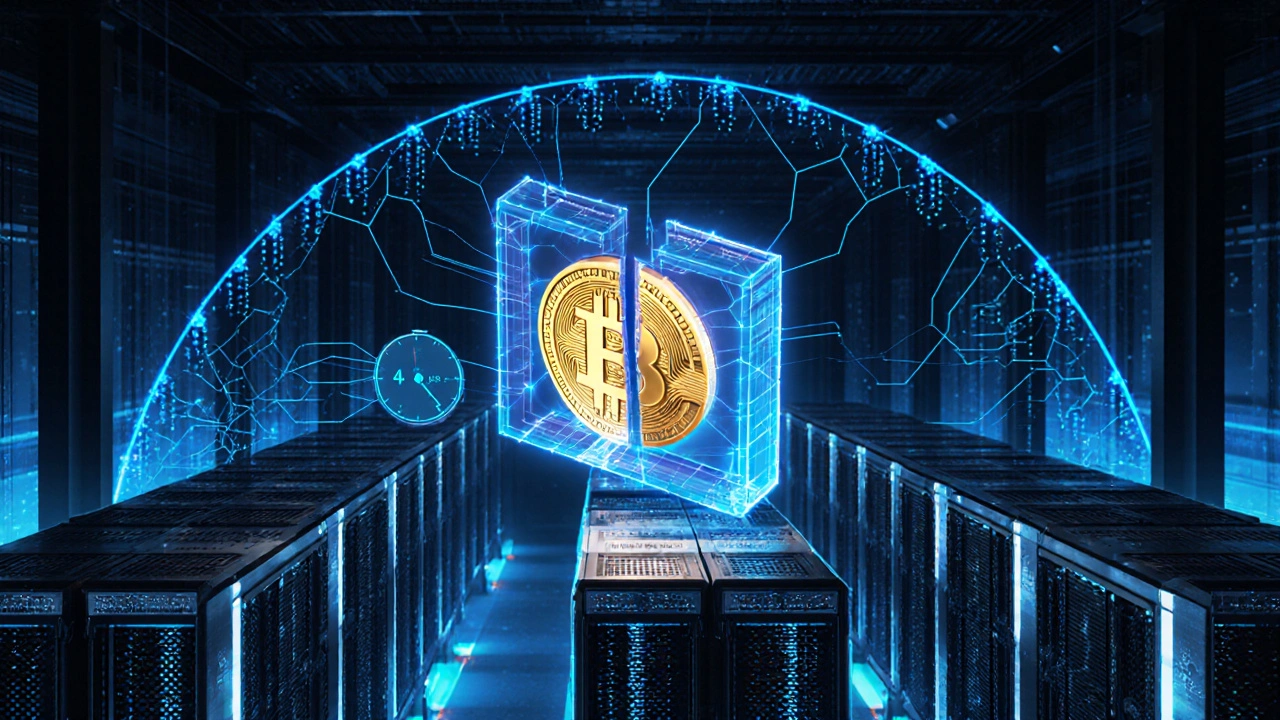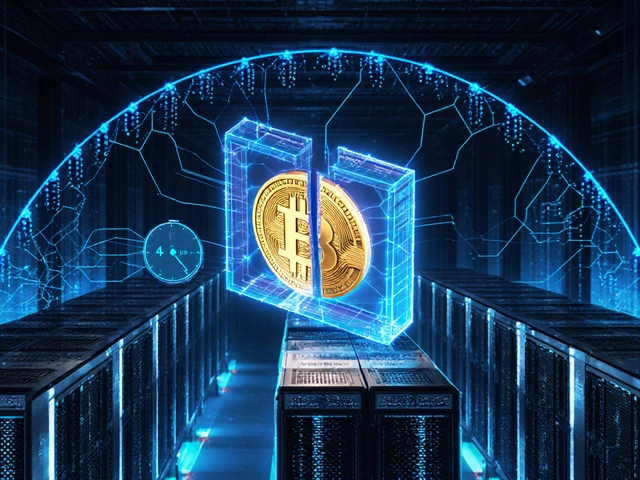Every four years something called a bitcoin halving shakes up the crypto world, cutting the reward miners earn for adding a new block to the blockchain. If you’ve ever wondered why a digital coin designed by a pseudonymous creator would deliberately reduce its own issuance, you’re in the right place. This guide breaks down the mechanics, the reasons, the history, and the practical effects on price, miners, and the broader market.
What the Halving Event Actually Is
Bitcoin is a decentralized digital currency that operates on a public ledger called the blockchain. The blockchain groups transactions into blocks, each of which is secured by a process known as mining. When a miner successfully hashes a block, the network grants a block reward - a set number of newly minted coins.
The halving event is a protocol‑level rule that cuts the block reward in half, roughly every 210,000 blocks (about four years). The first reward was 50 BTC per block in 2009; after the first halving in 2012 it dropped to 25 BTC, then to 12.5 BTC in 2016, and to 6.25 BTC in 2020. The latest halving, in May 2024, reduced the reward to 3.125 BTC, and the next one is expected around 2028‑2029.
Why Halving Is Built Into Bitcoin
The main reason is scarcity. Bitcoin’s creator, Satoshi Nakamoto, programmed a supply cap of 21million coins. By halving the reward at predictable intervals, the supply growth slows down over time, mimicking the extraction rate of precious metals like gold. This predictable scarcity is meant to protect against inflation and to give the currency a deflationary character.
Another technical reason is security. As the reward shrinks, the network relies more on transaction fees to keep miners interested. This shift encourages a healthy balance between block subsidies and market‑driven fees, ensuring that miners stay motivated to secure the network even when new coins become rarer.
How Halving Impacts the Bitcoin Economy
When the reward is cut, the immediate effect is a reduction in the flow of new bitcoins entering the market - roughly a 50% slowdown. Economic theory suggests that if demand stays constant while supply growth slows, price pressure can rise. Historical data supports this: each of the three halvings before 2020 was followed by a significant bull run, though the timing varied.
Beyond price, halving influences several key metrics:
- Miner revenue: Lower block rewards mean miners must earn more from transaction fees to stay profitable.
- Hashrate: Some miners shut down outdated equipment when revenue drops, causing short‑term dips in total network hashrate.
- Mining difficulty: The protocol adjusts difficulty roughly every two weeks to keep block times at 10 minutes, smoothing out short‑term hashrate changes.

Historical Halvings and Their Market Effects
| Halving Date | Block Reward (BTC) | Price 1Month Before | Price 1Month After | Peak Price Within 12Months |
|---|---|---|---|---|
| Nov282012 | 25 → 12.5 | $12 | $13 | $1,150 |
| Jul92016 | 12.5 → 6.25 | $660 | $610 | $19,800 |
| May112020 | 6.25 → 3.125 | $8,800 | $9,500 | $68,800 |
| May62024 | 3.125 → 1.5625 | $57,000 | $58,200 | $84,900 |
Notice the pattern: the price usually spikes months after the halving, not instantly. The lag reflects the time needed for miners to adjust, for new investors to notice the scarcity signal, and for broader market sentiment to shift.
What Miners Need to Know
For a miner, a halving is both a risk and an opportunity.
Risk comes from the reduced block subsidy. A mining operation that was barely profitable at 6.25BTC per block may find itself operating at a loss when the reward drops to 3.125BTC. Many miners respond by upgrading to more energy‑efficient ASICs or by joining mining pools to smooth out revenue.
Opportunity lies in fee dynamics. As block rewards shrink, users compete to have their transactions included, driving fee growth. In 2024, average transaction fees rose from $0.95 to $2.10 in the months after the halving, partially offsetting the revenue loss for large‑scale miners.
Another strategic move is geographic diversification. Electricity costs vary wildly; miners often relocate to regions with cheaper, renewable power when profitability tightens.
When Is the Next Halving?
Based on the 210,000‑block interval, the next halving should occur around block 840,000, projected for late 2028 or early 2029. At that point, the block reward will fall to 0.78125BTC.
Because block times can drift by a few seconds, the exact date isn’t fixed. Websites that track real‑time block height provide countdowns, and many analysts use these tools to anticipate market cycles.
Investors often watch the halving calendar as a benchmark for long‑term strategy. Some allocate a portion of their portfolio to Bitcoin in the year leading up to the event, betting on the historical pattern of post‑halving appreciation.

Common Misconceptions About Halving
- “Halving crashes the price.” In reality, the price usually climbs after a lag period. Immediate drops are rare and often linked to unrelated market news.
- “Miners stop mining after a halving.” Only the least efficient miners quit. The network still processes ~144 blocks per day, and the difficulty algorithm ensures block times stay stable.
- “Halving will happen forever.” Once the supply cap of 21million BTC is reached (estimated around 2140), the block reward will be zero, and miners will earn solely from fees.
Quick Checklist for Anyone Interested in Bitcoin Halving
- Understand the schedule: every 210,000 blocks (~4 years).
- Know the current block reward (3.125BTC as of 2024).
- Monitor miner profitability metrics (hashrate, electricity cost, fee trends).
- Watch price trends but expect a lag, not an instant jump.
- Plan long‑term: consider how fee income will support the network post‑supply cap.
Frequently Asked Questions
What triggers a Bitcoin halving?
The protocol automatically cuts the block reward in half every 210,000 blocks. No human intervention is needed; the change is hard‑coded into Bitcoin’s source code.
Will the halving affect my daily Bitcoin transactions?
Transaction speed stays the same (about 10 minutes per block). However, fees may rise as users compete for space in a block with a smaller subsidy.
How can I monitor the next halving date?
Track the current block height on any blockchain explorer. When the height approaches 840,000, the next halving is within weeks. Sites like BitcoinHalvingCountdown.com provide real‑time estimates.
Is Bitcoin still profitable for miners after the reward reaches zero?
By the time the block subsidy hits zero (around the year 2140), transaction fees are expected to be high enough to incentivize miners. The network’s security will then rely entirely on fee revenue.
Do halvings happen in other cryptocurrencies?
Some forks of Bitcoin, like Bitcoin Cash and Bitcoin SV, retain the halving rule. Others, such as Ethereum, use different supply mechanisms (e.g., “Ethereum’s transition to proof‑of‑stake removed block rewards altogether”).






